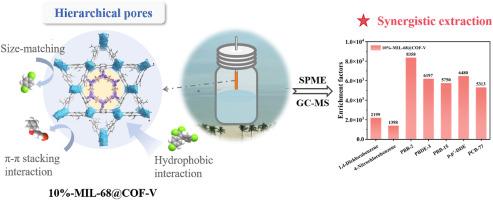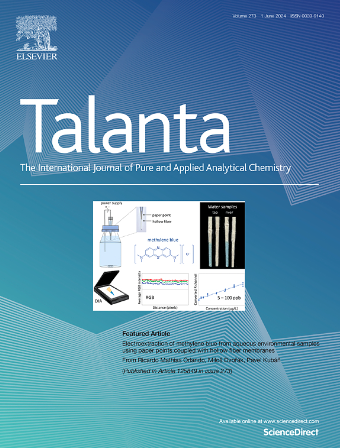Core-shell MOF@COFs with hierarchical pores for synergistic extraction of Cl/Br-substituted organic pollutants
IF 6.1
1区 化学
Q1 CHEMISTRY, ANALYTICAL
引用次数: 0
Abstract
Functionalized metal organic framework (MOF) and covalent organic framework (COF) composites (MOF@COFs) with complementary advantages, hierarchical pores, pre-designable and tunable structures, are expected for remarkable adsorption of organic pollutants, yet to be explored. Herein, a kind of MOF@COF composite was synthesized by combining the parent MIL-68(In) and COF–V (10 %-MIL-68@COF–V), characterized with well-retained crystallinity and hierarchical pores. The parent materials and as-prepared MIL-68@COF-Vs were further fabricated as solid phase microextraction (SPME) coatings to study their extraction performance for Cl/Br-substituted organic pollutants. The 10 %-MIL-68@COF–V coated fiber exhibited the most outstanding enrichment performance for Cl/Br-substituted organic pollutants mainly due to the synthetic advantages, which was 1.1–196.5 times superior than that of the commercial PDMS coating. By combining it with gas chromatography-mass spectrometry (GC-MS), an ultrasensitive method was established, exhibiting wide linear ranges (1–5000 ng L−1), low LODs (0.17–0.29 ng L−1), and good reproducibility. The trace Cl/Br-substituted organic pollutants in marine water samples were successfully detected, verifying the practicability of the developed method in environmental monitoring.

核壳MOF@COFs分级孔协同萃取Cl/ br取代的有机污染物
功能化金属有机骨架(MOF)和共价有机骨架(COF)复合材料(MOF@COFs)具有互补优势,分层孔隙,预设计和可调结构,有望对有机污染物进行显著的吸附,但仍有待探索。本文将母体MIL-68(In)和COF-V (10% -MIL-68@COF -V)结合合成了一种MOF@COF复合材料,具有良好的结晶度和分层孔隙。将母体材料和制备的MIL-68@COF-Vs制备成固相微萃取(SPME)涂层,研究其对Cl/ br取代的有机污染物的萃取性能。10% -MIL-68@COF -V包覆纤维对Cl/ br取代的有机污染物的富集性能最突出,主要是由于其合成优势,其富集性能是商品PDMS包覆纤维的1.1 ~ 196.5倍。结合气相色谱-质谱(GC-MS),建立了一种线性范围宽(1 ~ 5000 ng L−1)、检出限低(0.17 ~ 0.29 ng L−1)、重现性好的超灵敏方法。成功检测了海水样品中痕量Cl/ br取代的有机污染物,验证了该方法在环境监测中的实用性。
本文章由计算机程序翻译,如有差异,请以英文原文为准。
求助全文
约1分钟内获得全文
求助全文
来源期刊

Talanta
化学-分析化学
CiteScore
12.30
自引率
4.90%
发文量
861
审稿时长
29 days
期刊介绍:
Talanta provides a forum for the publication of original research papers, short communications, and critical reviews in all branches of pure and applied analytical chemistry. Papers are evaluated based on established guidelines, including the fundamental nature of the study, scientific novelty, substantial improvement or advantage over existing technology or methods, and demonstrated analytical applicability. Original research papers on fundamental studies, and on novel sensor and instrumentation developments, are encouraged. Novel or improved applications in areas such as clinical and biological chemistry, environmental analysis, geochemistry, materials science and engineering, and analytical platforms for omics development are welcome.
Analytical performance of methods should be determined, including interference and matrix effects, and methods should be validated by comparison with a standard method, or analysis of a certified reference material. Simple spiking recoveries may not be sufficient. The developed method should especially comprise information on selectivity, sensitivity, detection limits, accuracy, and reliability. However, applying official validation or robustness studies to a routine method or technique does not necessarily constitute novelty. Proper statistical treatment of the data should be provided. Relevant literature should be cited, including related publications by the authors, and authors should discuss how their proposed methodology compares with previously reported methods.
 求助内容:
求助内容: 应助结果提醒方式:
应助结果提醒方式:


